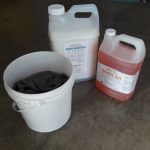I have covered wetcleaning basics for the last several months so starting this month, I will cover technical issues. The first issue is the chemicals used in wetcleaning.
Problem garments
I receive a lot of questions about handling problem garments. I suspect they think I am some kind of an expert in spotting but I am not actually. I just know wetcleaning chemicals. Most of these calls are about recovering from an accident. If they were using my Aqua Master chemicals, my success rate is pretty high but not so if some unknown chemicals are involved.
I do offer quite a bit of technical support to my customers and I advise them to call me first if uncertainty is involved. Thankfully, most of them do when handling special items like leather and suede, firs, wool suits and delicate silks. Once a problem occurs, recovery is difficult if not impossible with these delicate items. I really believe a phone call is the cheapest insurance.
Most accidents come from misuse of chemicals
Most problems come from improper use of chemicals. Color loss, localized color loss, rough texture, loss of sheen, stiffening of leather, shrinkage and etc. are all preventable as long as you understand your chemicals.
Successful wetcleaning requires both good machines and chemicals. But if I have to choose one, I will not hesitate to choose chemicals. I know many shops that do wetcleaning without specialized equipment. Choosing good chemicals is easier said than done so I would like to offer you the following guidelines.
1. Avoid strong alkali
I cannot stress this point enough. In wetcleaning wools and silks, strong alkali is a big no-no. Alkali attacks protein in wools and silks and resulting rough texture is impossible to fix.
Color or dye loss is another problem with a strong alkali. It’s best to stay neutral but most neutral products are seldom that. Most of them are slightly alkaline with pH of 8.5~9.
That’s why it’s best to choose an acidic product. Acidity not only protects the protein but also the dye. My detergent has a pH of 1.5. Its acidity is quite high but is safe for the skin and fabrics. Once it is mixed with water, the pH is about 6.
It’s best to avoid alkaline products when spotting too. Most laundry products are alkaline and should be avoided in wetcleaning.
2. Don’t give too much credit to chemical salesmen
Chemical reps do offer valuable services for all of us and they do know their products very well. But when it comes to wetcleaning, I doubt their expertise since it is a relatively new field. Especially when they are not a wetcleaner themselves. Experience beats knowledge when it comes to wetcleaning. A good product is something you used dozens of times without problems.
3. Don’t stinge on chemicals
You don’t save much when you stinge on chemicals. Good wetcleaning chemicals are the key to a successful wetcleaning. So don’t even bother looking for cheap alternatives.
Good chemicals cost more because they have good ingredients. Chemical costs is rarely more than 1 % of sales. There really is not much to save.
4. Keep it simple
Whenever I visit a dry cleaner, I see many spotting chemical products collecting dusts. I have to wonder if the spotter even knows what they are let alone how to use them. When it comes to spotting chemicals, it’s best to keep it simple.
I mainly use Stain Out and Grease Out. The rest is handled by a rust remover, protein formula and ink remover. When the list is short, it’s easier to train you staff.
Example of wetcleaning accident and recovery
A friend of mine came to me with a problem a while ago. It was a dark almond color silk blouse with blotches of color loss. He told me that he used a laundry chemical to remove spots. A strong alkaline chemical will do that no matter how much you dilute it. Luckily, the damage was not too bad so I tried the following method:
Bath treatment
In a bucket with 1.5 gal of water, I added 2 oz of Aqua Master Grease Out and 3 oz of Aqua Master Conditioner. The blouse was kept in this bath for a total of 3 hours. I checked it frequently to make sure there was an improvement. This bath gently took off some dye to make it even while the conditioner made it to appear richer. I sometimes use Stain Out instead but with a fragile dye, it’s safer to use Grease Out.
Rinse
After the bath, I gave it a light rinse. In the final rinse, I added 4~5 oz of the conditioner to 1.5 gal of water and the blouse was submerged for about 10 minutes. After light squeeze, I dried it on a hanger. The smell of Grease Out and Conditioner disappears once it dried.





